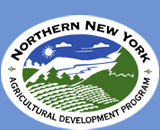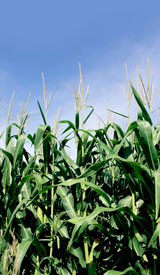American Society of Agronomy Ag Carbon Webinar:
August 12, 12 noon to 1pm Central Time
Climate Change … Carbon Sequestration … Green House Gases …
What Does It All Mean and What Will Agriculture’s Role Be?
A Special Two-Part Online Seminar
Presenters: Howard Brown, Jerry Hatfield, Dave Miller, Charles
Rice
Registration Now Open!
Click here for more info.
July 8, 2009
Contact: Bernadette Logozar, CCE Franklin County, 518-483-7403
Martha Pickard, ANCA, 518-891-6200
NNY Ag Development Program Posts Carbon Offset Info, Calculator
Online
Malone, NY -- The Northern New York Agricultural Development Program has
posted ag carbon offset and trading information online at
www.nnyagdev.org. The effort is a partnership with Cornell Cooperative
Extension, Adirondack North Country Association (ANCA), Northern New
York Farmers Partnership, Central NY Resource Conservation & Development
Council (CNY RC&D) and Vermont Pasture Network at the University of
Vermont Center for Sustainable Agriculture.
“These online resources are a way to help North Country farmers learn
about ag carbon offset and trading options that may provide marketing,
environmental stewardship or financial returns to them,” says Rural and
Agricultural Development Specialist Bernadette Logozar with Cornell
Cooperative Extension Franklin County, Malone, NY.
Ag carbon offset farming practices and ag carbon trading are ways to
reduce greenhouse gases (GHG).
For example, a manufacturing company may offset its GHG emissions by
purchasing carbon credits from a farmer, landowner or forest owner using
land practices that reduce the emissions of such gases as nitrous oxide,
methane or carbon dioxide.
Nitrous oxide released from nitrogen fertilizer, methane released from
manure and cows’ rumens, and carbon dioxide released by the use of
fossil fuels are three greenhouse gases associated with global warming
concerns.
The types of practices that farmers can undertake to build carbon
credits include no-till cropping, erosion control measures, use of
buffer areas, and land reforestation.
Conservation practices on farms can be used for carbon sequestration -
capturing and storing carbon dioxide in soil and vegetation. In some
areas, farmers can capture enough of the gas for it to be worthwhile to
sell the value of that sequestration as “carbon credits.”
Carbon credits are most often purchased by the industrial sector that
needs to offset the amount of greenhouse gases its manufacturing
practices release.
What value is there for Northern NY farmers in knowing about ag carbon
offsets?
Based on Northern New York’s agricultural land base, carbon offset
farming practices may have the greatest value for North Country farmers
as a marketing tool and a means of practicing environmental stewardship.
“The greatest value of ‘carbon offset farming’ in the North Country will
be educating the public about the environmental and economic benefits of
this type of management and incorporating this message into a farm
business marketing plan. At this time, ag carbon trading does not appear
to provide a financial incentive to North Country grass farmers due to
the relatively small farm acreages in the Northeast,” says ANCA
Agriculture-Grazing Program Coordinator. Martha Pickard. “We hope in
time that North Country producers will receive financial returns from
carbon offset and trading options.”
In April 2009, Vermont Pasture Network Coordinator Dr. Rachel Gilker
traveled to Northern New York to talk with the region’s farmers about
carbon offset and carbon trading. Gilker says, “The farmers of Northern
New York are clearly leaders in their interest in reducing greenhouse
gas emissions, and in understanding the production benefits that come
with these sustainable farming practices.”
Online Calculator Helps Dairy Farmers Figure Carbon Impact, Offset
At the NNY farmers meeting, Gilker shared an online Dairy Greenhouse
Gases Model software tool that helps dairy producers calculate their
carbon impact and offset opportunities. That model is among the online
resources in the Dairy section of the website at www.nnyagdev.org.
The Northern New York Agricultural Development Program website also
links to the Central NY Resource Conservation and Development Council ag
carbon resource collection that includes fact sheets on sources of
greenhouse gases in agriculture to contracts for selling ag carbon
credits.
The Agricultural Environmental Management section of the NNYADP website
also has whole farm nutrient management planning resources made possible
by on-farm research in Northern New York conducted by Cornell’s Nutrient
Management Spear Program. These resources are also helpful in reducing a
farm’s GHG emissions.
The Northern New York Agricultural Development Program is a farmer-led
research, education and technical assistance program for Clinton, Essex,
Franklin, Jefferson, Lewis and St. Lawrence counties. # # #
Ag Carbon Resources Online at
www.nnyagdev.org
The following information can be found online at www.nnyagdev.org:
• GHG is the abbreviation for greenhouse gases.*
• New York State contributes nearly 1 percent of the total global gas
emissions (USEPA)*
• Dairying contributes approximately 2 percent of New York’s total
greenhouse gas emissions*
• Agriculture contributes 20 percent to global gas emissions (IPCC:
Intergovernmental Panel on Climate Change)*
• Different manure handling systems produce different amounts of
greenhouse gas emissions*
• The Kyoto Protocol is an international cap-and-trade agreement that
limits a company’s amount of emissions output and allows buying and
selling of emission offset credits*
• DairyGHG uses process-based relationships and emission factors to
predict the primary GHG emissions from the production system.~
Key: * from resources provided by CNY RC&D; ~ from Dairy Greenhouse Gas
Model



